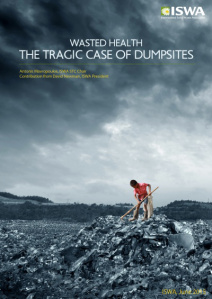Wasted Health: The Tragic Case of Dumpsites | | Source: by Thomas Dimech | Resource, 8 September 2015 |
A new report by the International Solid Waste Association (ISWA) is highlighting the ‘global health emergency’ affecting tens of millions of people in developing countries who lack good sanitation infrastructure. 
The report, ‘Wasted Health: The Tragic Case of Dumpsites’, illustrates how the issues surrounding open dumpsites in the developed world 40 years ago are still prevalent in developing countries, but are also being compounded by unprecedented issues such as the unregulated accumulation of discarded electronics, mobile phones, and medical waste.
Some of the main problems identified in the report include:
- open dumpsites receive roughly 40 per cent of the world’s waste and serve about 3.5 to 4 billion people;
- there has been a substantial rise in unregulated dumping of mobile devices, electronic appliances, medical and municipal waste, accelerating the scale of the threat and health risks;
- uncontrolled burning of waste releases gases and toxins into the atmosphere;
- open waste sites in India, Indonesia and the Philippines are more detrimental to life expectancy than malaria;
- 64 million people’s lives (equal to the population of France) are affected by world’s 50 largest dumpsites;
- in addition to the human and environmental impacts, the financial cost of open dumpsites runs into the tens of billions of US dollars.
Report’s statistics
In preparing the report, researchers analysed 373 toxic waste sites in India, Indonesia and the Philippines, where, the report says, ‘an estimated 8.6 million people are at risk of exposure to lead, asbestos, hexavalent chromium and other hazardous materials’.
It continues: ‘Among those people at risk, the exposure could cause a loss of around 829,000 years of good health as a result of disease, disability or early death. In comparison, malaria in these countries, whose combined population is nearly 1.6 billion, causes the loss of 725,000 healthy years.’
The report also states that over 42 million tonnes of e-waste was generated in 2014 and a lack of trained labour and investment in recycling infrastructure has meant that much of the waste is simply dumped in open landfills, which can lead to further health issues as they can be burnt, exposing locals to dangerous pollutants, heavy metals, volatile compounds and soot.
Call for a ‘global alliance’ to address the issue
Releasing the report, Antonis Mavropoulos, Chairman of the ISWA Scientific and Technical Committee and author of the report, called for immediate action: “Little or no coordinated action is being taken at present and to be effective change can only happen if there is a global alliance to address the issue among governments and key stakeholder organisations.
“We need to start with a plan of how we finance the closure and relocation of the most dangerous sites urgently and provide support through resources of capital and expertise. While the cost will be substantial, it represents an opportunity to invest in the infrastructure and economy of these emerging and poor nations. In addition, the outlay required to close the most risky dumpsites will be just a small fraction of the cost of their health impacts.”
David Newman, ISWA President, said: “The recommendations of this report are clear: the international community has an urgent task ahead in closing waste dumps globally, for the sake of populations affected by them, because they live in or near them, but also because all the world’s people are breathing in the toxins released by burning on open dumps. And the greenhouse gas emissions involved are huge too, and unless we act, the growth of open dumping is inevitable.”
He added: “ISWA and its experts are willing to take part in this global clean up and will, with other interested parties, collaborate on drawing attention to the damage caused to human health through poor waste management practices.”





